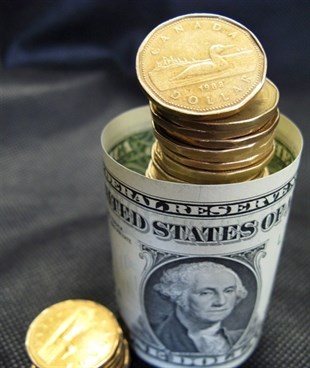
Canadian loonies are pictured with U.S dollars in this April 6, 2010 photo.
Image Credit: THE CANADIAN PRESS/Ryan Remiorz
July 07, 2014 - 5:04 AM
OTTAWA - With the resurgent loonie spoiling the Bank of Canada's best laid plans, has the time come for governor Stephen Poloz to take off the kid gloves?
The re-emergence of a muscular Canadian currency from as weak as 88.66 cents US in late March to about 94 cents US at the beginning of July may not seem ground-shifting given that not so long ago the loonie hovered around parity, but it is an anathema to what the central bank has been trying to achieve economically.
And the run may not be over. Should oil prices continue to climb and Statistics Canada, as expected, report strong jobs numbers next week, analysts say it may be entirely possible to see the loonie climb above 95 cents in the next week or two.
And that's where Poloz may need to come to the rescue, says Doug Porter, chief economist with BMO Capital Markets.
Poloz has been subtly undercutting the dollar for almost the past year in an effort to help exporters become more price competitive in foreign markets, most recently in June when he cited low inflation risks even as the consumer price index shot past the bank's target. But Porter believes it may be time to turn it up a notch.
"The governor of the Reserve Bank of Australia effectively just said he thought the Australian dollar was ridiculously high — they're not shy at all," he noted.
"(It) may be time to drop the caution. When every other central bank is doing what it can to cut its currency, you can't be bringing a knife to a gunfight, which is what the Bank of Canada is basically doing."
Poloz's aversion to a strong currency is based on his analysis that the Canadian economy needs to transition from housing and consumer driven growth to export-based expansion — particularly in the manufacturing sector that sustains populous Ontario and Quebec. A weaker loonie means exporters will be able to sell goods at relatively lower prices in the U.S., which buys about 70 per cent of Canadian exports.
The strategy had worked throughout the fall and winter months, but since April the currency has marched higher.
Poloz will get his next chance on July 16 with the release of the bank's quarterly monetary policy report and press conference, but Porter says he'll need to be more blunt.
It was not long ago that respected forecasting houses were talking about a 85-cent loonie, or even weaker.
But then the Canadian economy outperformed the U.S. during the winter months, inflation began heating up, which removed any risk Poloz would cut interest rates, and oil prices climbed — all positives for the loonie.
Scotiabank currency analyst Camilla Sutton said the loonie has likely overshot its fundamentals, but that doesn't mean the run is over.
"This trend is quite strong, so we could see it move higher for another week or two," she said, although she believes a more reasonable level for the loonie is 92 cents.
"We don't hear from the Bank of Canada until July 16 and, when we do, we are likely hear governor Poloz remind us repeatedly that the strength in the Canadian dollar is likely to weigh on the economic outlook. He's likely to be particularly concerned because we did start to see some improvement in the export numbers."
Aside from exporters, a low-flying loonie is welcome to the tourism industry and retailers, who have to worry less about cross-border shopping.
But it is not uniformly beneficial for the economy. Former Statistics Canada analyst Philip Cross has argued that a weak currency is not a net benefit for the country, as consumers pay more for imported goods and energy, while companies must pay more for most machinery and equipment.
Still, that's not how the Bank of Canada sees it. For the central bank, with the real estate boom believed to be all but spent, the Canadian economy won't be on a healthy "natural growth" track unless it becomes more competitive in international markets, and a lower loonie is a quick way of achieving that outcome.
"We continue to believe that rising global demand for Canadian goods and services, combined with the assumed high level of oil prices, will stimulate business investment in Canada and shift the economy to a more sustainable growth track," the bank said in April. "The lower Canadian dollar should provide additional support."
Such dull language was able to shave about one-third of a cent from the loonie's value at the time. Now, some believe Poloz may need to resort to a blunter message if the currency shows no signs of weakening.
News from © The Canadian Press, 2014